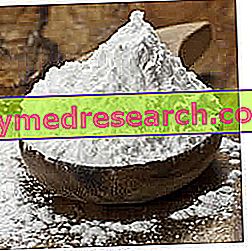Cassava or Yuca or Cassava
Cassava belongs to the family of Euphorbiaceae, Genus Manihot, Species esculenta ; the binomial nomenclature of the Cassava (also called yuca or cassava) is Manihot esculenta .
It is a tuber similar to a potato, but even more similar to a tuberous root (like the batata, commonly known as sweet potato or American potato).

Cassava is an important food source for those who populate its areas of origin, namely Central America; today, thanks to the remarkable profitability and the scarce cultural needs, the yuca is widely spread also in the African continent and in Asia.
Cassava can be consumed in different ways but is mainly cooked. By virtue of its chemical characteristics, the tuber also produces thin and white or yellow flour and starch (or rather starch).
WARNING! There is no single type of yuca; there are some varieties, called "bitter", containing some toxic principles ( manihotoxina, termolabile ); these plants, to be made edible, require intermediate processing or cooking steps.
The traditional recipes based on cassava are pureed and fried, but it is also included in mixed preparations, breaded as flour or pearls (NOT leavened) etc.
On an industrial level, cassava flour is used as a thickener and for the production of glucose, ethyl alcohol and beer.
Tapioca
Although it is often used as a synonym for the plant or flour or starch, tapioca is a very distinct product. It is in fact the result of a particular process, which uses wet starch as the starting point; subsequently, this last one is put to dry and agitated regularly to maintain the granular form of the agglomerates; it is therefore a starch and not a flour.
Tapioca is certainly the most refined product among all cassava derivatives.
Pudding with Tapioca Pearls - Tapioca Vanilla Pudding
X Problems with video playback? Reload from YouTube Go to Video Page Go to Video Recipes Section Watch the video on youtubeManioc flour, Tapioca, Yuca, Cassava
Cassava flour is obtained by grinding the tuberous root of Manihot esculenta, a sweet variety.
While for the potato the terms "flour" and "starch" are synonyms (since they indicate the same product), in the case of the yuca it is not so. The flour is in fact obtained from the milling, while the starch is deposited from the starch contained in the washing liquid of the pasta for the flour. The misunderstanding arises from the fact that, in most parts of the globe, cassava is exclusively marketed in starch (commonly called tapioca flour).
Below we will list the nutritional properties of commercially available cassava flour. First of all, the energy content is quite high but still lower than the classic wheat flour. From a chemical point of view, commercial cassava flour is mainly made up of starch and is much closer to potato starch than to cereal flour. It brings only small amounts of fiber, lipids and proteins; It does NOT contain gluten and as such is suitable for the consumption of celiac (gluten-free). WARNING! The fact that cassava flour originally does not contain gluten does not automatically mean that it is completely free; in fact, if it is produced or packaged in promiscuous establishments, it can be contaminated and become inappropriate for celiac disease nutrition.
With regard to mineral salts, small amounts of calcium and phosphorus are derived. In itself, yuca flour cannot be considered a food with additional functions to energy, so much so that a diet based mainly on its consumption leads to marked nutritional deficiencies.
Now, let's try to better understand the differences between manioc flour and starch:
- Yuca flour: water 10-14%, nitrogenous substances 1-2%, starchy substances 80-85%, fatty substances 0.2-0.4%, cellulose up to 1.5-3% and ash 1%.
- Cassava starch: water 13%, nitrogenous substances 1%, starchy substances 85%, fatty substances 0.2%, cellulose 0.4%, ashes 0.4%.
In practice, starch contains less nitrogenous substances, cellulose and ashes than flour.



